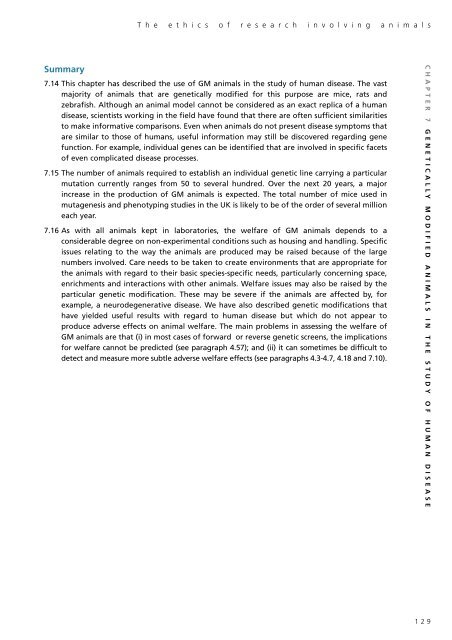The ethics of research involving animals - Nuffield Council on ...
The ethics of research involving animals - Nuffield Council on ...
The ethics of research involving animals - Nuffield Council on ...
You also want an ePaper? Increase the reach of your titles
YUMPU automatically turns print PDFs into web optimized ePapers that Google loves.
T h e e t h i c s o f r e s e a r c h i n v o l v i n g a n i m a l s<br />
Summary<br />
7.14 This chapter has described the use <str<strong>on</strong>g>of</str<strong>on</strong>g> GM <str<strong>on</strong>g>animals</str<strong>on</strong>g> in the study <str<strong>on</strong>g>of</str<strong>on</strong>g> human disease. <str<strong>on</strong>g>The</str<strong>on</strong>g> vast<br />
majority <str<strong>on</strong>g>of</str<strong>on</strong>g> <str<strong>on</strong>g>animals</str<strong>on</strong>g> that are genetically modified for this purpose are mice, rats and<br />
zebrafish. Although an animal model cannot be c<strong>on</strong>sidered as an exact replica <str<strong>on</strong>g>of</str<strong>on</strong>g> a human<br />
disease, scientists working in the field have found that there are <str<strong>on</strong>g>of</str<strong>on</strong>g>ten sufficient similarities<br />
to make informative comparis<strong>on</strong>s. Even when <str<strong>on</strong>g>animals</str<strong>on</strong>g> do not present disease symptoms that<br />
are similar to those <str<strong>on</strong>g>of</str<strong>on</strong>g> humans, useful informati<strong>on</strong> may still be discovered regarding gene<br />
functi<strong>on</strong>. For example, individual genes can be identified that are involved in specific facets<br />
<str<strong>on</strong>g>of</str<strong>on</strong>g> even complicated disease processes.<br />
7.15 <str<strong>on</strong>g>The</str<strong>on</strong>g> number <str<strong>on</strong>g>of</str<strong>on</strong>g> <str<strong>on</strong>g>animals</str<strong>on</strong>g> required to establish an individual genetic line carrying a particular<br />
mutati<strong>on</strong> currently ranges from 50 to several hundred. Over the next 20 years, a major<br />
increase in the producti<strong>on</strong> <str<strong>on</strong>g>of</str<strong>on</strong>g> GM <str<strong>on</strong>g>animals</str<strong>on</strong>g> is expected. <str<strong>on</strong>g>The</str<strong>on</strong>g> total number <str<strong>on</strong>g>of</str<strong>on</strong>g> mice used in<br />
mutagenesis and phenotyping studies in the UK is likely to be <str<strong>on</strong>g>of</str<strong>on</strong>g> the order <str<strong>on</strong>g>of</str<strong>on</strong>g> several milli<strong>on</strong><br />
each year.<br />
7.16 As with all <str<strong>on</strong>g>animals</str<strong>on</strong>g> kept in laboratories, the welfare <str<strong>on</strong>g>of</str<strong>on</strong>g> GM <str<strong>on</strong>g>animals</str<strong>on</strong>g> depends to a<br />
c<strong>on</strong>siderable degree <strong>on</strong> n<strong>on</strong>-experimental c<strong>on</strong>diti<strong>on</strong>s such as housing and handling. Specific<br />
issues relating to the way the <str<strong>on</strong>g>animals</str<strong>on</strong>g> are produced may be raised because <str<strong>on</strong>g>of</str<strong>on</strong>g> the large<br />
numbers involved. Care needs to be taken to create envir<strong>on</strong>ments that are appropriate for<br />
the <str<strong>on</strong>g>animals</str<strong>on</strong>g> with regard to their basic species-specific needs, particularly c<strong>on</strong>cerning space,<br />
enrichments and interacti<strong>on</strong>s with other <str<strong>on</strong>g>animals</str<strong>on</strong>g>. Welfare issues may also be raised by the<br />
particular genetic modificati<strong>on</strong>. <str<strong>on</strong>g>The</str<strong>on</strong>g>se may be severe if the <str<strong>on</strong>g>animals</str<strong>on</strong>g> are affected by, for<br />
example, a neurodegenerative disease. We have also described genetic modificati<strong>on</strong>s that<br />
have yielded useful results with regard to human disease but which do not appear to<br />
produce adverse effects <strong>on</strong> animal welfare. <str<strong>on</strong>g>The</str<strong>on</strong>g> main problems in assessing the welfare <str<strong>on</strong>g>of</str<strong>on</strong>g><br />
GM <str<strong>on</strong>g>animals</str<strong>on</strong>g> are that (i) in most cases <str<strong>on</strong>g>of</str<strong>on</strong>g> forward or reverse genetic screens, the implicati<strong>on</strong>s<br />
for welfare cannot be predicted (see paragraph 4.57); and (ii) it can sometimes be difficult to<br />
detect and measure more subtle adverse welfare effects (see paragraphs 4.3-4.7, 4.18 and 7.10).<br />
CHAPTER 7 GENETICALLY MODIFIED ANIMALS IN THE STUDY OF HUMAN DISEASE<br />
129
















